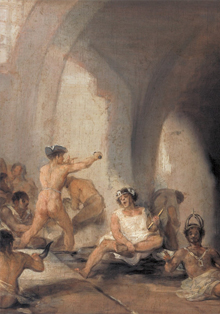The Sala Hércules (Room 1) and Sala de Calcografía Nacional (Room 2) of the Real Academia de Bellas Artes San Fernando in Madrid are hosting the exhibition Goya. The Awakening of Conscience.
The exhibition highlights the change of attitude of Francisco de Goya (1746-1828) towards the world through his graphic and pictorial creations, with the added value of presenting, for the first time in history, all the copper plates that Goya created and used to print his engravings, restored.
Throughout his long life, Goya produced an immense body of work using different techniques such as oil painting, fresco and engraving, in which very different conceptions and ways of painting can be appreciated. In this exhibition we can see the differences between his early works and those produced in his maturity, to the extent that they appear to be by different artists. Thus, the works he painted when he came to court show a style in tune with the prevailing artistic trends of his time, and it was in his mature period that Goya showed a critical attitude towards the reality around him and the dominant artistic norms in painting. In this awakening of conscience, the painter moved away from the academic conditioning factors and changed his attitude as a painter, which was no longer just a profession for him, but a means of expression of his vital and critical attitude.
This exhibition is dedicated to highlighting this aspect of Goya’s work and personality. It also contains a group of works that deserve special mention, the copper plates made for the series of engravings of the Caprichos, the Desastres de la guerra and the Disparates (conserved at the Academia, in the Calcografía Nacional), which have recently been restored.
The exhibition is divided into four sections: The Painter, the Norm and the Clientele; The Awakening of Conscience; A Painting on the Margins of Style ; and The Expressiveness of Reason. Made up of paintings, drawings, prints and engravings, they show Goya’s artistic and vital evolution.







